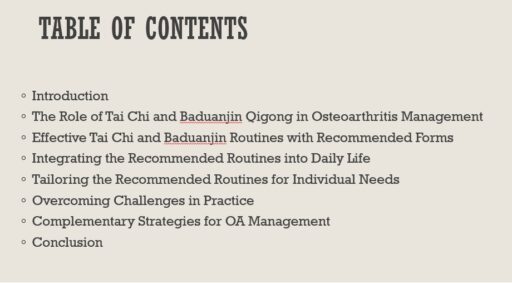Osteoarthritis (OA) affects millions worldwide, causing pain and limiting mobility. Recent research highlights two gentle exercise practices—Tai Chi and Baduanjin Qigong—as effective tools for OA management.

A tutorial with details is available for ATCQA Members and Certified Instructors/Practitioners. Other people can purchase the tutorial for a small fee in our online store.
Proven Benefits
A systematic review of 12 studies with over 4,900 participants revealed these practices significantly reduce pain, improve mobility, enhance balance, and boost quality of life. Their low-impact movements and mindful breathing techniques make them ideal for people with joint issues.
How They Help
- Balance & Flexibility: Improve postural stability and prevent falls.
- Joint-Friendly Movements: Gentle, flowing motions enhance mobility without straining joints.
- Mind-Body Connection: Mindfulness reduces stress, complementing physical benefits.
Getting Started
Warm-Up: Begin with arm circles and rhythmic breathing to prepare your body.
Core Movements:
- Tai Chi Forms: Wave Hands Like Clouds, Golden Rooster Stands on One Leg, Grasp Sparrow’s Tail.
- Baduanjin Exercises: Holding the Sky, Drawing the Bow, Separating Heaven and Earth.
Cool-Down: End with breathing exercises to relax and reflect on your session.
Daily Integration
Incorporate these practices into daily life: use Tai Chi’s mindful steps during walks or try Baduanjin movements during breaks. Beginners can start with short sessions and gradually increase duration, while seated or modified forms can suit older adults with mobility issues.
Tai Chi and Baduanjin Qigong empower OA patients to manage symptoms effectively. Start small, stay consistent, and enjoy the journey toward healthier, more resilient joints!